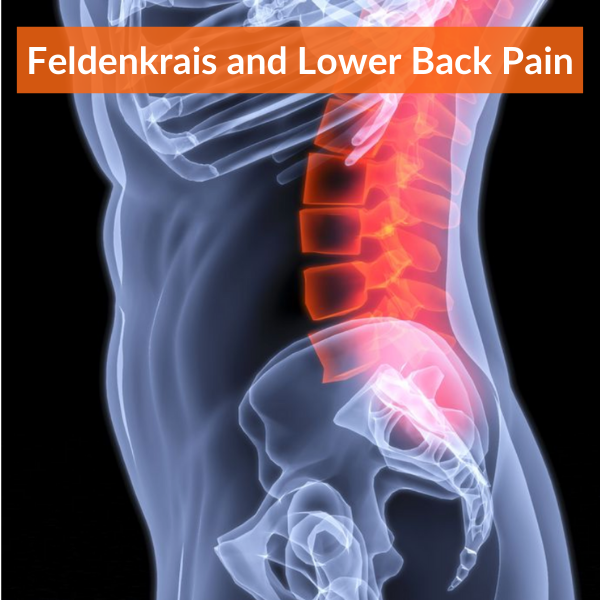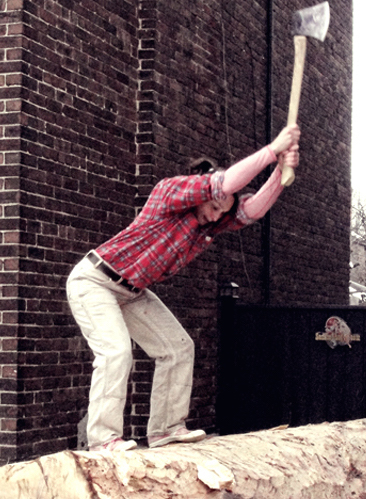
This is edited reprint of a former post about Feldenkrais for lower back pain and why strength and flexibility don’t cut it.
This post is written specifically for people who want to understand why they’re having back pain even after doing everything they’ve been told by medical professionals and/or fitness coaches. And why the Feldenkrais approach to lower back pain can be the solution.
If you want to…
- overcome back pain or prevent back injury
- to be able to do more of the stuff you love without worrying about your back
- move with with more power and efficiency
- learn how Feldenkrais helps with lower back pain
Read on…
Because, struggling with chronic or recurring back issues is frustrating. You can be doing everything you’re ‘supposed’ to do — but to no avail.
And the angst. What’s your future going to be like if things don’t get better?
If you’re committed to getting well but are frustrated by the results you’ve gotten so far, this may very well provide the missing piece – the key that makes all the difference.
The first thing to know is its not your fault.
I’ve seen the same thing with clients who are pro hockey players, pro dancers (contemporary and ballet), contortionists, young, old, strong, not so strong, super flexible, super inflexible….
Because here’s the thing….
It’s not about how strong you are. And it’s not about how flexible you are.
If it was just about strength, then why do I get clients like pro hockey players who blow a disc picking a kleenex up off the floor?
And if it was just about flexibility, then why would I see the same issues with ballerina’s and other professional dancers? They are both strong AND flexible to be sure.
Heck, I’ve even seen this issue in a professional contortionist — plenty flexible.
So what gives?
Here’s the thing…
Most exercise/fitness programs will address things like core stability when it comes to back pain. And the good ones will incorporate exercises for both the font and the back of the abdominal wall. Some will even include the pelvic floor. And this is good.
Even with these ‘good’ programs, there is usually one insanely important muscle left out…
The diaphragm. The main breathing muscle. And just to be clear, its not enough to just have instructions that tell you when to breath in and when to breath out while doing your exercises. Which brings me to the point of this post.
Its not about the muscles!
Or the joints. Or the discs.
Think for a moment: What is it the controls the muscles? What is it that controls the movements of the joints?
Yup – I’m sure you thought it. Its your b-r-a-i-n.
Your brain is the hub from which your motor plans are activated. “Motor plans” is just a fancy way of saying co-ordination/or brain nerve pathways (more or less).
See, what’s usually happening if someone continues to have back pain after the acute phase of an injury has passed, is that the timing of the muscle contractions required to do the movement are what gets messed up. Even with the strong and flexible people. It’s the way the movement is co-ordinated.
Imagine your favourite music group. All the members of the group can be awesome musicians in their own right. They can all have superior musical skill and play the right notes. But if they don’t play their notes in the right time relative to everyone else in the group, they will still sound like crap.
It’s the same with your movements. Each of your muscles might, in fact, be sufficiently strong to do their job. But if they don’t activate with proper timing, in harmony with all the rest of you, you can still feel like crap.
You’d be surprised just how much more ease and lightness a person can feel when they get their movements organized well. With just a little switch in how you do a movement, your ability to generate useful power can go up a remarkable amount. No “strengthening” required.
This timing. This movement organization I’m talking about is so fast and nuanced, you cannot (no one can!) make the proper timing happen just by being told to “pull your belly button in”, for example.
Besides, in everyday life, you’re too busy attending to the task at hand to have that much deliberate focus on every muscle contraction you make. It’s simply impossible. If that was how you tried to learn to ride a bike, you’d never have learned to stay upright.
So what the heck is one to do?
Start thinking more holistically. It’s not about muscles, its about movement… The Quality of Movement.
But first, you need to get an idea of at least one more thing.
Because its huge.
This is the thing that is almost always left out of even the best ‘core stability’ program. That good ol’ diaphragm thingy I mentioned earlier, the primary breathing muscle. Only, its not just for breathing.
Here’s the deal…
Let’s keep things really simple by using an easy to visualize model…
Start thinking of your abdominal cavity as a cylinder – more or less – like a can of soup. There are three ‘sides’ to that cylinder: the vertical part (where the label goes around), the bottom, and the top.
In you, the vertical part is your circumference — front/sides/back. This is your abdominal wall, low back and all around your pelvis. The floor is your pelvic floor muscles. The top is your diaphragm/breathing muscle (which does more than just pull air in and push air out out of your lungs).
Again this is just a model to keep things simple. Of course your diaphragm is domed, not flat, for example, but that’s not crucial for our purposes here.
An important part of keeping your spine functionally stable is your intra-abdominal pressure — the pressure inside this abdominal ‘cylinder’.
Hmmm — I went and introduced another term: functionally stable. In the physio world I came from this was often called dynamic stability.
What I mean by functionally stable is stability that is useful for life. It’s a stability that allows mobility. And this is where using Feldenkrais to help you overcome back pain is brilliant.
If you rigidify yourself unnecessarily, you make moving through the world harder than necessary. You compress you joints, work against yourself, and create shearing forces across your joints. This results in inefficient movement, wasted energy and wear and tear on your system.
What you want is to have exquisitely organized intra-abdominal pressure that is constantly modulating to meet the demands of the moment. You want stability that does not prevent mobility.
In order to get this beautifully organizing, modulating intra-abdominal pressure, you need all the parts of your cylinder working hand in hand. Your abdominal wall, your back…AND pelvic foor…
…AND your diaphragm.
Actually, you want every bit of yourself working hand in hand, and especially your pelvis/hip joints, head, and neck, as well as your abdominal cylinder.
But again, for the sake of simplicity, we’ll focus on this idea of your ‘core’ — your abdominal cylinder (low back/abdominal/pelvic region).
Unfortunately, what often happens with exercise programs is that instead of attending to how you organize yourself to move from a co-ordination perspective, you attend to strengthening and/or getting into a pose (like in yoga). And often, this is done in any possible way you can. To make matters worse — people often feel like the harder they’re working the better.
In reality, when a person moves with true functional core stability, it looks e-f-f-o-r-t-l-e-s-s.
Not effortful.
Just think of the most amazing athletes. Or the most amazing dancers…
They move with grace.
With ease.
Even when they are moving with great power.
Better yet, think of how amazing it is to watch a baby doing the superman (or should I say super-baby) pose. You know, the one where they’re on their stomach, their head up, eyes level and on the horizon, all four limbs off the floor, in the air…

Feldenkrais understood something key re: lower back pain & function
Or how easily they can lift their head from the floor or put their toes in their mouths when on their back.
And they manage all this with heads so big compared to the rest of themselves they can’t touch their hands over top their head. And they can do this a crazy of number of times a day!
Think of a toddler who can do hundreds and hundreds of full squats a day, get up and down off the floor every which way 10’s of times a day — day after day after day!
Neither the baby nor the toddler get up each day groaning and moaning because their abs, back, glutes, or quads muscles are crazy sore from all the work they did the day before.
They aren’t strong, these little ones.
But they are doing something special.
Special only in the sense that too many adults just don’t do this anymore. But in reality – its not special at all.
Its beautiful, natural human movement.
See, they’ve had no choice but to figure out to move the way humans were meant to move. They don’t have the strength to cheat. And it generally doesn’t include pulling in the tummy the way so many of us try to do.
You might be thinking this is crazy. How could I be saying it’s not about core muscle strength? Certainly you’ve got to contract your muscles! Don’t you?
Of course you do. But all too often, it’s the way people increase the tone in their muscles that’s gone awry.
So how do you change this?
It goes without saying that I don’t believe one blog post could ever give you all you need to know to move out of pain.
But I can give you some guidelines and a few sensations to look for that can have a big impact on the quality of your movements and so, the amount of pain you suffer.
There are several important principles that are key when learning better movement patterns. A couple that are important to highlight here are:
• effortlessness and comfort.
Comfort is easy enough. You don’t want to create more pain. That’s pretty obvious. But it’s more than that…
It’s all about learning. If you want to learn something easily, quickly, and deeply so the new way of moving becomes more natural and habitual so you don’t have to think about it…
…then its important to move without increasing pain.
It’s a biological imperative to avoid pain. We have pain receptors to warn us that something is wrong, dangerous, and/or injuring. Our nervous system wants nothing more than for us to change the situation so we get away from the danger and/or stop doing the thing that’s causing injury. This is bad for quality learning.
So, when in the process of learning, don’t go into pain.
The other one I mentioned was effortlessness. Another way to describe this is effortless effort.
Do whatever you do with a quality of effortless effort.
For the sake of clarity, the example I often give is this…
If you’re squatting 400 lbs (assuming you can do so safely), keep squatting the 400 lbs, but do so with a feeling of less effort. The only way you can keep doing whatever you are doing with less effort is by moving with greater efficiency. In other words, with better co-ordination.
Since you can’t consciously isolate each specific muscle to contract a few milliseconds before or after another and there are way too many elements to ever keep track of consciously, what you have to go for is a general feeling.
That general feeling is one of effortlessness.
Back to intra-abdominal pressure — the pressure inside your abdominal cylinder….
So lets explore a movement you can actual do to get a feeling of what this modulating intra-abdominal pressure might feel like.
One example that the founder of the method I practice — Dr. Moshe Feldenkrais of the Feldenkrais MethodⓇ — uses in his book The Potent Self is that of chopping wood.
Go ahead and actually do the following:
• Stand up with your feet comfortably wide
• Bring your two hands together as though you’re holding the handle of a large axe
• Swing your arms up as though you are swinging the axe overhead (remember —- effortlessness and comfort! Don’t do anything that hurts you.)
• And just as the axe changes direction so you are about to swing the axe with great force to chop wood…
—> Right then, just as the axe changes direction, if you’re using your pelvis/hip joints, and your arms are not consciously contracted and your chest is free to let air out simply and spontaneously…
You’ll notice that there is a quality of pressure in the lowest part of your abdomen — a fullness…

This fullness (if you’re chopping with quality movement — with effortless power) is what I’m talking about when talking about intra-abdominal pressure. Great martial artists know this feeling very well (as do world champion lumberjacks).
You might need to do the movement many times to get a feel for it, especially if you haven’t moved and generated power with a potent belly for a long time.
Another example Dr. Feldenkrais gives is the movement in the lower part of the belly of a dog when he barks, or a lion when he roars.
Even us humans, if we want to project our voice with great power and clarity, there’ll be that feeling of having this fullness in the lower belly.
Go ahead and try it. Start singing a note and progressively make it louder and louder. Try it while pulling your belly in, making yourself smaller. Then try it with pressure in your lower belly, making it denser/fuller. You’ll not only project more with less effort, you’ll feel like your getting a little taller, and broader. You’ll feel more powerful — not just sound more powerful. All opera singers know this.
Another example of this is the very strong and forceful “ha!” sound martial artists use and some yogi’s teach.
And here is one more hint (actually – I hinted at it above).
If you increase the tone in the muscles of your trunk so that you feel you make yourself smaller — as in — you compress yourself or squeeze yourself — that’s not it.
When you need to exert some force, some power, the feeling you’re looking for is one that makes you feel more expansive in all directions: a little taller, broader, and deeper.
This way of increasing the tone in your belly while feeling the fullness of your belly and your true stature is what provides wonderful, functional core stability for the low back.
In fact, it’d be better to say that this is the source of all powerful human movement for your entire self — not just your low back.
It doesn’t matter if the increased power you need is to lift your groceries out of your car, push a lawn mower, carry your kid, run a mile, backpack, portage a canoe, play soccer, lift your head from the floor….or chop wood….whatever you need power for.
It’s not about how strong the muscles are, as wonderful and beneficial as strong muscles can be.
And it’s not about how flexible you are. Because even someone who isn’t super bendy can move quite well and without back pain.
It’s about how you organize those muscles.
Once you start organizing yourself with better movement patterns — then you can do whatever you want, better. And by all means, get fitter, stronger, nimbler, healthier…
But without that underlying quality organization of your movements, it can be an unnecessarily long, tough road to finding comfort again, if at all.
Would you like to do something more substantial to start re-organizing your movement patterns? Get a sense of what a small but potent change in the way you organize your abdominal cylinder can do for you, access The Introduction to Feldenkrais Sampler Library. The very first Awareness Through Movement® lesson, “Breathing in Many Positions” will help you do just that.
Because Feldenkrais for back pain is highly effective!
The Introduction to Feldenkrais Sampler Library is available to you for $0. Join here.


Hi, Thanks for sharing such an amazing post on Lower back pain. Above all of these, I was looking was something like this and find this very helpful. Thanks again for sharing such an amazing post! Best Regards.